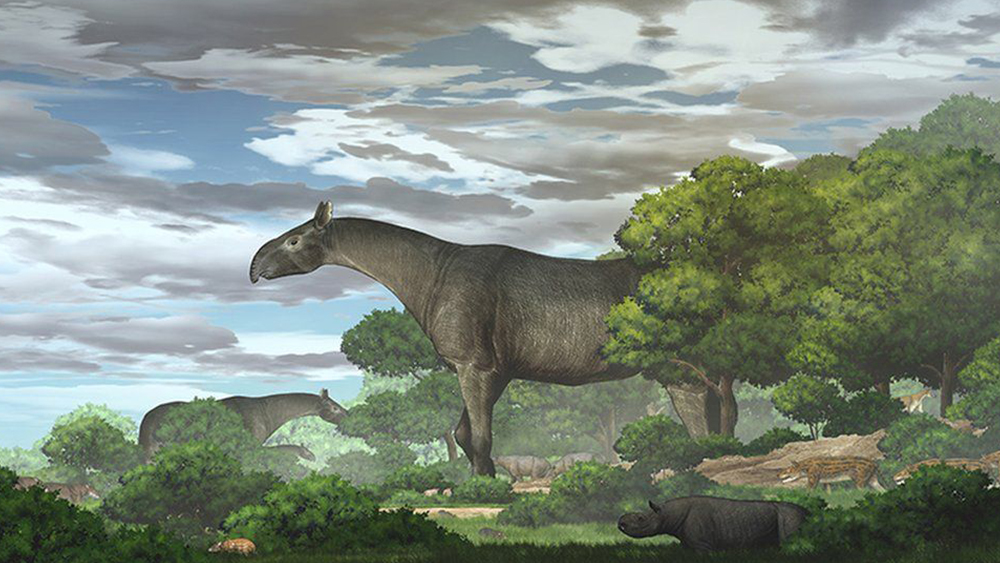Fossils from two giant rhinos dated by evolutionists to be “22 million years old” in the evolutionary timetable have been discovered in China.1 They were much larger than today’s rhinos and stood at over 20 feet, but they were still rhinos. This is true with many large animals found in the fossil record—vertebrate and invertebrate. For example, there are giant water bug fossils from the Crato Formation in northeastern Brazil, the giant ground sloth (Megatherium), and giant crocodile (Deinosuchus) found in ten U.S. states. In all three cases they are simply much larger versions of their animal cousins alive today. Real, vertical evolution is not recorded.
So it is with the rhinoceros.
Evolutionists do not know the origin of the rhinoceroses. They can only suggest that the rhinocerotoids evolved from perissodactyls (an order of odd-toed ungulates) “millions of years ago.” In 2001, Colbert said, “The first known rhinoceroses appear in sediments of Eocene age,” and “it is likely that the earliest rhinoceroses were closely related to the primitive tapirs.”2 Almost two decades later, the evolutionary picture hasn’t changed: “They are believed to have evolved from tapir-like forms.”3
Yet, the fossil record doesn’t have clear answers on how the rhino came to be. The scientists analyzing the giant rhino state, “As one of the largest land mammals, the origin and evolution of the giant rhino Paraceratherium bugtiense in Pakistan have been unclear.”1 Like all animals, the rhino appears complete and fully-formed in the sedimentary rocks. Giant rhinos4 have always been giant rhinos as God created them thousands of years ago. They were buried in the receding stage (Tejas Megasequence) of the Genesis Flood.5
Stage image: Artistic rendering of giant rhinos.
Stage image credit: Yu Chen. Copyright © 2021. Adapted for use in accordance with federal copyright (fair use doctrine) law. Usage by ICR does not imply endorsement of copyright holders.
References
1. Deng, T. et al. 2021. An Oligocene giant rhino provides insights into Paraceratherium evolution. Communications Biology. 4 (639): 1.
2. Colbert, E. et al. 2001. Colbert’s Evolution of the Vertebrates, 5th ed. Wiley-Liss Publishers, 472.
3. Allaby, M. 2020. Dictionary of Zoology. Fifth edition. 532. See also Sherwin, F. 2010. Tapir: Testimony to Creation. Acts & Facts. 39 (1): 15.
4. Fortelius, M. & J. Kappelman. 1993. The largest land mammal ever imagined. Zoology Journal of the Linnean Society. 107: 85–101.
5. Tomkins, J.P. and T. Clarey. 2020. Paleontology Confirms a Late Cenozoic N-Q Flood Boundary. Acts & Facts. 49 (11).
*Dr. Sherwin is Research Associate at the Institute for Creation Research. He earned an M.A. in zoology from the University of Northern Colorado and received an Honorary Doctorate of Science from Pensacola Christian College.

Giant Rhinos Are Still Rhinos
The Latest
Puzzling Fossils at an Unlikely Time
Wherever and whenever life is found, it is incredibly complex. This certainly applies to cyanobacterial photosynthetic life that supposedly were some...
CREATION PODCAST
A Theory Designed to Be...Anti-Design | The Creation Podcast:...
Science is objective. At least, that’s what we’re told. But there are inherent issues with this statement that can...
Seeing the Case for Creation in Fruit Flies
Our brain is designed to smoothly and constantly process what we see via the incredibly sensitive photoreceptors (cones and rods) of our eyes.1...
Amazing Defense Systems
Bacteria (prokaryotes) are ubiquitous. A fraction cause disease in people, animals, and plants, but the majority are the foundation for the global food...
Octopus and Fish Plan a Complex Coordinated Hunt
The octopus—an invertebrate—never fails to surprise researchers with its incredible abilities.1,2
The octopus was designed...
A ''40 million year old'' 100% European Gnat
Finding well-preserved creatures in amber1 is a landfall for creation scientists, much like the numerous discoveries of soft dinosaur tissue...
CREATION PODCAST
The Undeniable Power of Narrative | The Creation Podcast: Episode...
Science is objective. At least, that’s what we’re told. But there are inherent issues with this statement that can cause...
Paintbrush of the Creator
Who doesn’t enjoy the amazing color patterns of butterflies?1,2 Such beautiful designs and construction do not reflect blind naturalistic...
November 2024 ICR Wallpaper
"Rejoice always, pray without ceasing, in everything give thanks; for this is the will of God in Christ Jesus for you." (1 Thessalonians 5:16-18 NKJV)
ICR...



















